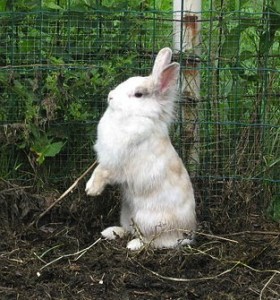
The care and housing of rabbits that you will breed for food is the same as any rabbit care, although slightly larger cages for the females is a good idea since they will also have to be big enough to hold the babies until they are ready to be weaned.
There are only a few rules you should be aware of before you start out to avoid some common pitfalls:
Never—I repeat never—take the buck (male rabbit) to the doe’s (female rabbit) cage! It is the female of the rabbit species that is territorial, and she will rip him a new one. Even if she doesn’t do any serious physical damage to him, and she’ll try, they won’t get much breeding done.
Always take the female to the male. She won’t be aggressive in a strange cage, and he will know exactly what to do.
Do stay and watch when you leave the doe in the buck’s cage. It is not a long term process. The breeding will be over in a very short time. In fact the longest part is the buck chasing the doe around even the tiniest of cages. Once he catches her, it will be done in seconds. Do not leave the doe in the buck’s cage for an extended period of time—not even minutes after the deed is done. She will start to feel comfortable, he won’t be on his guard because he is too busy feeling good, and she will get territorial and may attack him. It’s not worth losing a good buck over. Grab her out of the cage as soon as the buck has done his duty.
If you only breed during summer months, you won’t have to do much other than provide a nice nesting box that is the right size for your doe. She will do all the work. In the winter, however, it is a necessary to place a heat lamp above the cage to make sure the kits (newborn bunnies) stay warm enough.
One thing you should always watch for as the doe’s due date draws near is whether or not she is building a nest. She should start pulling her belly hair out and using it to line the nesting box. If she doesn’t, or hasn’t pulled enough hair for a deep warm nest, you can add straw to the box to make sure there is plenty of insulation even in the summer months.
One of the most common problems encountered in rabbit breeding is the doe having the kits outside of the nest box. This happens most often with first-time moms. Keep a close eye on any maiden does having a first litter to be sure she delivers them inside the box. If you see she is having them on the cage floor, you have a few minutes to get them into the box, and put her in with them.
That’s another very important reason to always watch and carefully plan your breeding dates by taking the doe to the buck and taking her out immediately afterwards. If you don’t know when the doe is due, you can’t watch for problems. It also helps you to know when to put the nest box in the cage with the doe. Breeding rabbits is very easy and takes little extra work beyond the normal care and feeding, and with just a few extra precautions you can end up with quite a bit of extra meat in your freezer.
©2011 Off the Grid News